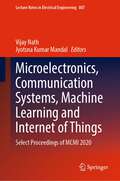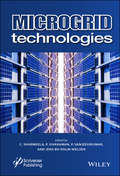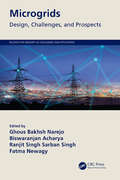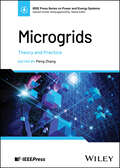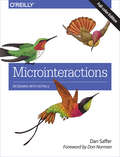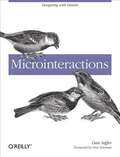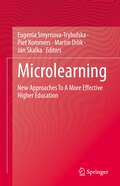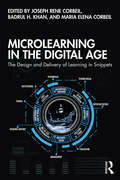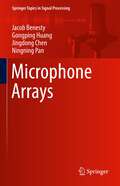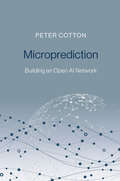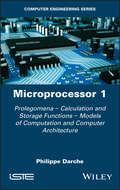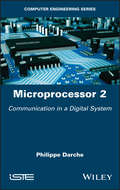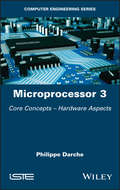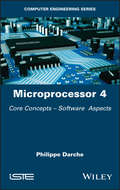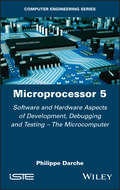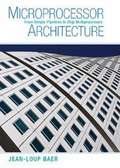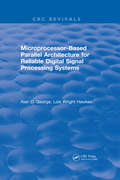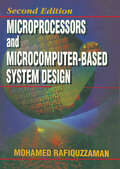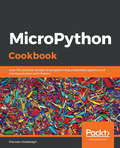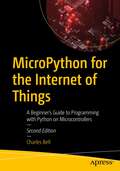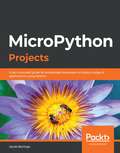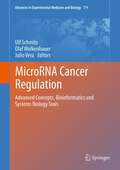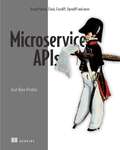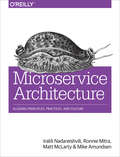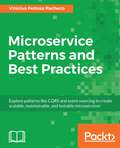- Table View
- List View
Microelectronics, Communication Systems, Machine Learning and Internet of Things: Select Proceedings of MCMI 2020 (Lecture Notes in Electrical Engineering #887)
by Vijay Nath Jyotsna Kumar MandalThis volume presents peer-reviewed papers of the First International Conference on Microelectronics, Communication Systems, Machine Learning, and the Internet of Things (MCMI-2020). This book discusses recent trends in technology and advancement in microelectronics, nano-electronics, VLSI design, IC technologies, wireless communications, optical communications, SoC, advanced instrumentations, signal processing, internet of things, machine learning, image processing, green energy, hybrid vehicles, weather forecasting, cloud computing, renewable energy, CMOS sensors, actuators, RFID, transducers, real-time embedded system, sensor network and applications, EDA design tools and techniques, fuzzy logic & artificial intelligence, high-performance computer architecture, AI-based robotics & applications, brain-computer interface, deep learning, advanced operating systems, supply chain development & monitoring, physical systems design, ICT applications, e-farming, information security, etc. It includes original papers based on theoretical, practical, experimental, simulations, development, application, measurement, and testing. The applications and solutions discussed in the book will serve as good reference material for young scholars, researchers, and academics.
Microgrid Technologies
by C. Sharmeela P. Sivaraman P. Sanjeevikumar Jens Bo Holm-NielsenMicrogrid technology is an emerging area, and it has numerous advantages over the conventional power grid. A microgrid is defined as Distributed Energy Resources (DER) and interconnected loads with clearly defined electrical boundaries that act as a single controllable entity concerning the grid. Microgrid technology enables the connection and disconnection of the system from the grid. That is, the microgrid can operate both in grid-connected and islanded modes of operation. Microgrid technologies are an important part of the evolving landscape of energy and power systems. Many aspects of microgrids are discussed in this volume, including, in the early chapters of the book, the various types of energy storage systems, power and energy management for microgrids, power electronics interface for AC & DC microgrids, battery management systems for microgrid applications, power system analysis for microgrids, and many others. The middle section of the book presents the power quality problems in microgrid systems and its mitigations, gives an overview of various power quality problems and its solutions, describes the PSO algorithm based UPQC controller for power quality enhancement, describes the power quality enhancement and grid support through a solar energy conversion system, presents the fuzzy logic-based power quality assessments, and covers various power quality indices. The final chapters in the book present the recent advancements in the microgrids, applications of Internet of Things (IoT) for microgrids, the application of artificial intelligent techniques, modeling of green energy smart meter for microgrids, communication networks for microgrids, and other aspects of microgrid technologies. Valuable as a learning tool for beginners in this area as well as a daily reference for engineers and scientists working in the area of microgrids, this is a must-have for any library.
Microgrids: Design, Challenges, and Prospects (Big Data for Industry 4.0)
by Ghous Bakhsh Narejo Biswaranjan Acharya Ranjit Singh Sarban Singh Fatma NewagyThe book addresses the needs of researchers on the fundamentals as well as more advanced knowledge on microgrids and their evolution. This book covers newly emerging trends in fields such as Computer Science, Energy, Electrical Engineering, and Electronics and brings the reader up-to-date on the new emerging fields that play an important role in the power infrastructure. This book provides knowledge on decision making for newly evolving trends in microgrid design. It discusses techniques on how to improve the existing power quality and reduce load shedding and power imbalances. The book presents the emerging fields that now play an important role in microgrid design such as Data Science, Machine Learning, AI, and IT. The readership includes researchers, academia, practicing engineers, consumers, power companies and policy makers located across the globe.
Microgrids: Theory and Practice (IEEE Press Series on Power and Energy Systems)
by Peng ZhangMicrogrids Understand microgrids and networked microgrid systems Microgrids are interconnected groups of energy sources that operate together, capable of connecting with a larger grid or operating independently as needed and network conditions require. They can be valuable sources of energy for geographically circumscribed areas with highly targeted energy needs, and for remote or rural areas where continuous connection with a larger grid is difficult. Microgrids’ controllability makes them especially effective at incorporating renewable energy sources. Microgrids: Theory and Practice introduces readers to the analysis, design, and operation of microgrids and larger networked systems that integrate them. It brings to bear both cutting-edge research into microgrid technology and years of industry experience in designing and operating microgrids. Its discussions of core subjects such as microgrid modeling, control, and optimization make it an essential short treatment, valuable for both academic and industrial study. Readers will acquire the skills needed to address existing problems and meet new ones as this crucial area of power engineering develops. Microgrids: Theory and Practice also features: Incorporation of new cyber-physical system technologies for enabling microgrids as resiliency resources Theoretical treatment of a wide range of subjects including smart programmable microgrids, distributed and asynchronous optimization for microgrid dispatch, and AI-assisted microgrid protection Practical discussion of real-time microgrids simulations, hybrid microgrid design, transition to renewable microgrid networks, and more Microgrids: Theory and Practice is ideal as a textbook for graduate and advanced undergraduate courses in power engineering programs, and a valuable reference for power industry professionals looking to address the challenges posed by microgrids in their work.
Microinteractions: Designing with Details
by Dan SafferIt's the little things that turn a good digital product into a great one. With this full color practical book, you'll learn how to design effective microinteractions: the small details that exist inside and around features. How can users change a setting? How do they turn on mute, or know they have a new email message? Through vivid, real-world examples from today's devices and applications, author Dan Saffer walks you through a microinteraction's essential parts, then shows you how to use them in a mobile app, a web widget, and an appliance. You'll quickly discover how microinteractions can change a product from one that's tolerated into one that's treasured. Explore a microinteraction's structure: triggers, rules, feedback, modes, and loops Learn the types of triggers that initiate a microinteraction Create simple rules that define how your microinteraction can be used Help users understand the rules with feedback, using graphics, sounds, and vibrations Use modes to let users set preferences or modify a microinteraction Extend a microinteraction's life with loops, such as "Get data every 30 seconds"
Microinteractions
by Dan SafferIt's the little things that turn a good digital product into a great one. With this practical book, you'll learn how to design effective microinteractions: the small details that exist inside and around features. How can users change a setting? How do they turn on mute, or know they have a new email message? Through vivid, real-world examples from today's devices and applications, author Dan Saffer walks you through a microinteraction's essential parts, then shows you how to use them in a mobile app, a web widget, and an appliance. You'll quickly discover how microinteractions can change a product from one that's tolerated into one that's treasured. Explore a microinteraction's structure: triggers, rules, feedback, modes, and loops Learn the types of triggers that initiate a microinteraction Create simple rules that define how your microinteraction can be used Help users understand the rules with feedback, using graphics, sounds, and vibrations Use modes to let users set preferences or modify a microinteraction Extend a microinteraction's life with loops, such as "Get data every 30 seconds"
Microlearning: New Approaches To A More Effective Higher Education
by Eugenia Smyrnova-Trybulska Piet Kommers Martin Drlík Ján SkalkaThis book is about the most significant developments in the field of microlearning in the teaching of programming. In particular, the book covers the creation of content and the use of microlearning activities for automatically evaluating programming assignments. These critical component of microlearning represent a significant contribution both in fulfilling individual project objectives and in improving computer programming education in general. The book is interdisciplinary, examining both computer science and education. Specific topics explored include: development of distance courses, creating microcourses, fostering interdisciplinary knowledge, IT, management, and theoretical, methodological and practical aspects of the implementation of microlearning. Additionally, comprehensive analysis of the scientific literature (monographs, articles, proceedings) on the subject of the project and conducted research is provided.
Microlearning in the Digital Age: The Design and Delivery of Learning in Snippets
by Joseph Rene CorbeilMicrolearning in the Digital Age explores the design and implementation of bite-sized learning and training in technology-enabled environments. Grounded in research-based best practices and a robust, eight-dimensional framework, this book applies the latest developments in mobile learning, social media, and instructional/multimedia design to one of today’s most innovative and accessible content delivery systems. Featuring experts from higher education, information technology, digital gaming, corporate, and other contexts, this comprehensive guide will prepare graduate students, researchers, and professionals of instructional design, e-learning, and distance education to develop engaging, cost-effective microlearning systems.
Microphone Arrays (Springer Topics in Signal Processing #22)
by Jacob Benesty Gongping Huang Jingdong Chen Ningning PanThis book explains the motivation for using microphone arrays as opposed to using a single sensor for sound acquisition. The book then goes on to summarize the most useful ideas, concepts, results, and new algorithms therein. The material presented in this work includes analysis of the advantages of using microphone arrays, including dimensionality reduction to remove the redundancy while preserving the variability of the array signals using the principal component analysis (PCA). The authors also discuss benefits such as beamforming with low-rank approximations, fixed, adaptive, and robust distortionless beamforming, differential beamforming, and a new form of binaural beamforming that takes advantage of both beamforming and human binaural hearing properties to improve speech intelligibility. The book makes the microphone array signal processing theory and applications available in a complete and self-contained text. The authors attempt to explain the main ideas in a clear and rigorous way so that the reader can easily capture the potentials, opportunities, challenges, and limitations of microphone array signal processing. This book is written for those who work on the topics of microphone arrays, noise reduction, speech enhancement, speech communication, and human-machine speech interfaces.
Microprediction: Building an Open AI Network
by Peter CottonHow a web-scale network of autonomous micromanagers can challenge the AI revolution and combat the high cost of quantitative business optimization.The artificial intelligence (AI) revolution is leaving behind small businesses and organizations that cannot afford in-house teams of data scientists. In Microprediction, Peter Cotton examines the repeated quantitative tasks that drive business optimization from the perspectives of economics, statistics, decision making under uncertainty, and privacy concerns. He asks what things currently described as AI are not &“microprediction,&” whether microprediction is an individual or collective activity, and how we can produce and distribute high-quality microprediction at low cost. The world is missing a public utility, he concludes, while companies are missing an important strategic approach that would enable them to benefit—and also give back. In an engaging, colloquial style, Cotton argues that market-inspired &“superminds&” are likely to be very effective compared with other orchestration mechanisms in the domain of microprediction. He presents an ambitious yet practical alternative to the expensive &“artisan&” data science that currently drains money from firms. Challenging the machine learning revolution and exposing a contradiction at its heart, he offers engineers a new liberty: no longer reliant on quantitative experts, they are free to create intelligent applications using general-purpose application programming interfaces (APIs) and libraries. He describes work underway to encourage this approach, one that he says might someday prove to be as valuable to businesses—and society at large—as the internet.
Microprocessor 1: Prolegomena - Calculation and Storage Functions - Models of Computation and Computer Architecture
by Philippe DarcheSince its commercialization in 1971, the microprocessor, a modern and integrated form of the central processing unit, has continuously broken records in terms of its integrated functions, computing power, low costs and energy saving status. Today, it is present in almost all electronic devices. Sound knowledge of its internal mechanisms and programming is essential for electronics and computer engineers to understand and master computer operations and advanced programming concepts. This book in five volumes focuses more particularly on the first two generations of microprocessors, those that handle 4- and 8- bit integers. Microprocessor 1 – the first of five volumes – presents the computation function, recalls the memory function and clarifies the concepts of computational models and architecture. A comprehensive approach is used, with examples drawn from current and past technologies that illustrate theoretical concepts, making them accessible.
Microprocessor 2: Communication in a Digital System
by Philippe DarcheCalculation is the main function of a computer. The central unit is responsible for executing the programs. The microprocessor is its integrated form. This component, since the announcement of its marketing in 1971, has not stopped breaking records in terms of computing power, price reduction and integration of functions (calculation of basic functions, storage with integrated controllers). It is present today in most electronic devices. Knowing its internal mechanisms and programming is essential for the electronics engineer and computer scientist to understand and master the operation of a computer and advanced concepts of programming. This first volume focuses more particularly on the first generations of microprocessors, that is to say those that handle integers in 4 and 8-bit formats. The first chapter presents the calculation function and reminds the memory function. The following is devoted to notions of calculation model and architecture. The concept of bus is then presented. Chapters 4 and 5 can then address the internal organization and operation of the microprocessor first in hardware and then software. The mechanism of the function call, conventional and interrupted, is more particularly detailed in a separate chapter. The book ends with a presentation of architectures of the first microcomputers for a historical perspective. The knowledge is presented in the most exhaustive way possible with examples drawn from current and old technologies that illustrate and make accessible the theoretical concepts. Each chapter ends if necessary with corrected exercises and a bibliography. The list of acronyms used and an index are at the end of the book.
Microprocessor 3: Core Concepts - Hardware Aspects
by Philippe DarcheCalculation is the main function of a computer. The central unit is responsible for executing the programs. The microprocessor is its integrated form. This component, since the announcement of its marketing in 1971, has not stopped breaking records in terms of computing power, price reduction and integration of functions (calculation of basic functions, storage with integrated controllers). It is present today in most electronic devices. Knowing its internal mechanisms and programming is essential for the electronics engineer and computer scientist to understand and master the operation of a computer and advanced concepts of programming. This first volume focuses more particularly on the first generations of microprocessors, that is to say those that handle integers in 4 and 8-bit formats. The first chapter presents the calculation function and reminds the memory function. The following is devoted to notions of calculation model and architecture. The concept of bus is then presented. Chapters 4 and 5 can then address the internal organization and operation of the microprocessor first in hardware and then software. The mechanism of the function call, conventional and interrupted, is more particularly detailed in a separate chapter. The book ends with a presentation of architectures of the first microcomputers for a historical perspective. The knowledge is presented in the most exhaustive way possible with examples drawn from current and old technologies that illustrate and make accessible the theoretical concepts. Each chapter ends if necessary with corrected exercises and a bibliography. The list of acronyms used and an index are at the end of the book.
Microprocessor 4: Core Concepts - Software Aspects
by Philippe DarcheSince its commercialization in 1971, the microprocessor, a modern and integrated form of the central processing unit, has continuously broken records in terms of its integrated functions, computing power, low costs and energy saving status. Today, it is present in almost all electronic devices. Sound knowledge of its internal mechanisms and programming is essential for electronics and computer engineers to understand and master computer operations and advanced programming concepts. This book in five volumes focuses more particularly on the first two generations of microprocessors, those that handle 4- and 8- bit integers. Microprocessor 4 – the fourth of five volumes – addresses the software aspects of this component. Coding of an instruction, addressing modes and the main features of the Instruction Set Architecture (ISA) of a generic component are presented. Futhermore, two approaches are discussed for altering the flow of execution using mechanisms of subprogram and interrupt. A comprehensive approach is used, with examples drawn from current and past technologies that illustrate theoretical concepts, making them accessible.
Microprocessor 5: Software and Hardware Aspects of Development, Debugging and Testing - The Microcomputer
by Philippe DarcheSince its commercialization in 1971, the microprocessor, a modern and integrated form of the central processing unit, has continuously broken records in terms of its integrated functions, computing power, low costs and energy saving status. Today, it is present in almost all electronic devices. Sound knowledge of its internal mechanisms and programming is essential for electronics and computer engineers to understand and master computer operations and advanced programming concepts. This book in five volumes focuses more particularly on the first two generations of microprocessors, those that handle 4- and 8- bit integers. Microprocessor 5 – the fifth and final volume of this series of books – first presents the hardware and software aspects of the development chain of a microprocessor-based digital system. Finally, to round up the series and offer a historical perspective, the architectures of the first microcomputers are detailed. A comprehensive approach is used, with examples drawn from current and past technologies that illustrate theoretical concepts, making them accessible.
Microprocessor Architecture: From Simple Pipelines to Chip Multiprocessors
by Jean-Loup BaerThis book gives a comprehensive description of the architecture of microprocessors from simple in-order short pipeline designs to out-of-order superscalars. It discusses topics such as - the policies and mechanisms needed for out-of-order processing such as register renaming, reservation stations, and reorder buffers - optimizations for high performance such as branch predictors, instruction scheduling, and load-store speculations - design choices and enhancements to tolerate latency in the cache hierarchy of single and multiple processors - state-of-the-art multithreading and multiprocessing emphasizing single chip implementations Topics are presented as conceptual ideas, with metrics to assess the performance impact, if appropriate, and examples of realization. The emphasis is on how things work at a black box and algorithmic level. The author also provides sufficient detail at the register transfer level so that readers can appreciate how design features enhance performance as well as complexity.
Microprocessor-Based Parallel Architecture for Reliable Digital Signal Processing Systems
by Alan D. GeorgeThis book presents a distributed multiprocessor architecture that is faster, more versatile, and more reliable than traditional single-processor architectures. It also describes a simulation technique that provides a highly accurate means for building a prototype system in software. The system prototype is studied and analyzed using such DSP applications as digital filtering and fast Fourier transforms. The code is included as well, which allows others to build software prototypes for their own research systems. The design presented in Microprocessor-Based Parallel Architecture for Reliable Digital Signal Processing Systems introduces the concept of a dual-mode architecture that allows users a dynamic choice between either a conventional or fault-tolerant system as application requirements dictate. This volume is a "must have" for all professionals in digital signal processing, parallel and distributed computer architecture, and fault-tolerant computing.
Microprocessors and Microcomputer-Based System Design
by Mohamed RafiquzzamanMicroprocessors and Microcomputer-Based System Design, Second Edition, builds on the concepts of the first edition. It discusses the basics of microprocessors, various 32-bit microprocessors, the 8085 microprocessor, the fundamentals of peripheral interfacing, and Intel and Motorola microprocessors. This edition includes new topics such as floating-point arithmetic, Program Array Logic, and flash memories. It covers the popular Intel 80486/80960 and Motorola 68040 as well as the Pentium and PowerPC microprocessors. The final chapter presents system design concepts, applying the design principles covered in previous chapters to sample problems.
MicroPython Cookbook: Over 110 practical recipes for programming embedded systems and microcontrollers with Python
by Marwan AlsabbaghLearn how you can control LEDs, make music, and read sensor data using popular microcontrollers such as Adafruit Circuit Playground, ESP8266, and the BBC micro:bitKey FeaturesLoad and execute your first program with MicroPythonProgram an IoT device to retrieve weather data using a RESTful APIGet to grips with integrating hardware, programming, and networking concepts with MicroPythonBook DescriptionMicroPython is an open source implementation of Python 3 that runs in embedded environments. With MicroPython, you can write clean and simple Python code to control hardware instead of using complex low-level languages like C and C++. This book guides you through all the major applications of the MicroPython platform to build and program projects that use microcontrollers.The MicroPython book covers recipes that’ll help you experiment with the programming environment and hardware programmed in MicroPython. You’ll find tips and techniques for building a variety of objects and prototypes that can sense and respond to touch, sound, position, heat, and light. This book will take you through the uses of MicroPython with a variety of popular input devices and sensors. You’ll learn techniques for handling time delays and sensor readings, and apply advanced coding techniques to create complex projects. As you advance, you’ll get to deal with Internet of Things (IoT) devices and integration with other online web services. Furthermore, you'll also use MicroPython to make music with bananas and create portable multiplayer video games that incorporate sound and light animations into the game play.By the end of the book, you'll have mastered tips and tricks to troubleshoot your development problems and push your MicroPython project to the next level!What you will learnExecute code without any need for compiling or uploading using REPL (read-evaluate-print-loop)Program and control LED matrix and NeoPixel drivers to display patterns and colorsBuild projects that make use of light, temperature, and touch sensorsConfigure devices to create Wi-Fi access points and use network modules to scan and connect to existing networksUse Pulse Width Modulation to control DC motors and servosBuild an IoT device to display live weather data from the Internet at the touch of a buttonWho this book is forIf you want to build and program projects that use microcontrollers, this book will offer you dozens of recipes to guide you through all the major applications of the MicroPython platform. Although no knowledge of MicroPython or microcontrollers is expected, a general understanding of Python is necessary to get started with this book.
MicroPython for the Internet of Things: A Beginner’s Guide to Programming with Python on Microcontrollers
by Charles BellThis book will help you quickly learn to program for microcontrollers and IoT devices without a lot of study and expense. MicroPython and controllers that support it eliminate the need for programming in a C-like language, making the creation of IoT applications and devices easier and more accessible than ever. MicroPython for the Internet of Things is ideal for readers new to electronics and the world of IoT. Specific examples are provided covering a range of supported devices, sensors, and MicroPython boards such as the Raspberry Pi Pico and the Arduino Nano Connect RP2040 board. Programming for microcontrollers has never been easier. The book takes a practical and hands-on approach without a lot of detours into the depths of theory. It’ll show you a faster and easier way to program microcontrollers and IoT devices, teach you MicroPython, a variant of one of the most widely used scripting languages, and is written to be accessible to those new to electronics. After completing this book, and its fun example projects, you’ll be ready to ready to use MicroPython to develop your own IoT applications. What You Will Learn Program in MicroPython Understand sensors and basic electronics Develop your own IoT projects Build applications for popular boards such as Raspberry Pi Pico and Arduino Nano Connect RP2040 Load MicroPython on compatible boards Interface with hardware breakout boards Connect hardware to software through MicroPython Explore connecting your microcontroller to the cloud Develop IoT projects for the cloud Who This Book Is For Anyone interested in building IoT solutions without the heavy burden of programming in C++ or C. The book also appeals to those wanting an easier way to work with hardware than is provided by platforms that require more complex programming environments.
MicroPython Projects: A do-it-yourself guide for embedded developers to build a range of applications using Python
by Jacob BeningoExplore MicroPython through a series of hands-on projects and learn to design and build your own embedded systems using the MicroPython Pyboard, ESP32, the STM32 IoT Discovery kit, and the OpenMV camera module. Key Features Delve into MicroPython Kernel and learn to make modifications that will enhance your embedded applications Design and implement drivers to interact with a variety of sensors and devices Build low-cost projects such as DIY automation and object detection with machine learning Book Description With the increasing complexity of embedded systems seen over the past few years, developers are looking for ways to manage them easily by solving problems without spending a lot of time on finding supported peripherals. MicroPython is an efficient and lean implementation of the Python 3 programming language, which is optimized to run on microcontrollers. MicroPython Projects will guide you in building and managing your embedded systems with ease. This book is a comprehensive project-based guide that will help you build a wide range of projects and give you the confidence to design complex projects spanning new areas of technology such as electronic applications, automation devices, and IoT applications. While building seven engaging projects, you'll learn how to enable devices to communicate with each other, access and control devices over a TCP/IP socket, and store and retrieve data. The complexity will increase progressively as you work on different projects, covering areas such as driver design, sensor interfacing, and MicroPython kernel customization. By the end of this MicroPython book, you'll be able to develop industry-standard embedded systems and keep up with the evolution of the Internet of Things. What you will learn Develop embedded systems using MicroPython Build a custom debugging tool to visualize sensor data in real-time Detect objects using machine learning and MicroPython Discover how to minimize project costs and reduce development time Get to grips with gesture operations and parsing gesture data Learn how to customize and deploy the MicroPython kernel Explore the techniques for scheduling application tasks and activities Who this book is for If you are an embedded developer or hobbyist looking to build interesting projects using MicroPython, this book is for you. A basic understanding of electronics and Python is required while some MicroPython experience will be helpful.
MicroRNA Cancer Regulation
by Julio Vera Olaf Wolkenhauer Ulf SchmitzThis edited reflects the current state of knowledge about the role of microRNAs in the formation and progression of solid tumours. The main focus lies on computational methods and applications, together with cutting edge experimental techniques that are used to approach all aspects of microRNA regulation in cancer. We are sure that the emergence of high-throughput quantitative techniques will make this integrative approach absolutely necessary in the near future. This book will be a resource for researchers starting out with cancer microRNA research, but is also intended for the experienced researcher who wants to incorporate concepts and tools from systems biology and bioinformatics into his work. Bioinformaticians and modellers are provided with a general perspective on microRNA biology in cancer, and the state-of-the-art in computational microRNA biology.
Microservice APIs: Using Python, Flask, FastAPI, OpenAPI and more
by Jose Haro PeraltaStrategies, best practices, and patterns that will help you design resilient microservices architecture and streamline your API integrations.In Microservice APIs, you&’ll discover: Service decomposition strategies for microservices Documentation-driven development for APIs Best practices for designing REST and GraphQL APIs Documenting REST APIs with the OpenAPI specification (formerly Swagger) Documenting GraphQL APIs using the Schema Definition Language Building microservices APIs with Flask, FastAPI, Ariadne, and other frameworks Service implementation patterns for loosely coupled services Property-based testing to validate your APIs, and using automated API testing frameworks like schemathesis and Dredd Adding authentication and authorization to your microservice APIs using OAuth and OpenID Connect (OIDC) Deploying and operating microservices in AWS with Docker and Kubernetes Microservice APIs teaches you practical techniques for designing robust microservices with APIs that are easy to understand, consume, and maintain. You&’ll benefit from author José Haro Peralta&’s years of experience experimenting with microservices architecture, dodging pitfalls and learning from mistakes he&’s made. Inside you&’ll find strategies for delivering successful API integrations, implementing services with clear boundaries, managing cloud deployments, and handling microservices security. Written in a framework-agnostic manner, its universal principles can easily be applied to your favorite stack and toolset. About the technology Clean, clear APIs are essential to the success of microservice applications. Well-designed APIs enable reliable integrations between services and help simplify maintenance, scaling, and redesigns. Th is book teaches you the patterns, protocols, and strategies you need to design, build, and deploy effective REST and GraphQL microservices APIs. About the book Microservice APIs gathers proven techniques for creating and building easy-to-consume APIs for microservices applications. Rich with proven advice and Python-based examples, this practical book focuses on implementation over philosophy. You&’ll learn how to build robust microservice APIs, test and protect them, and deploy them to the cloud following principles and patterns that work in any language. What's inside Service decomposition strategies for microservices Best practices for designing and building REST and GraphQL APIs Service implementation patterns for loosely coupled components API authorization with OAuth and OIDC Deployments with AWS and Kubernetes About the reader For developers familiar with the basics of web development. Examples are in Python. About the author José Haro Peralta is a consultant, author, and instructor. He&’s also the founder of microapis.io. Table of Contents PART 1 INTRODUCING MICROSERVICE APIS 1 What are microservice APIs? 2 A basic API implementation 3 Designing microservices PART 2 DESIGNING AND BUILDING REST APIS 4 Principles of REST API design 5 Documenting REST APIs with OpenAPI 6 Building REST APIs with Python 7 Service implementation patterns for microservices PART 3 DESIGNING AND BUILDING GRAPHQL APIS 8 Designing GraphQL APIs 9 Consuming GraphQL APIs 10 Building GraphQL APIs with Python PART 4 SECURING, TESTING, AND DEPLOYING MICROSERVICE APIS 11 API authorization and authentication 12 Testing and validating APIs 13 Dockerizing microservice APIs 14 Deploying microservice APIs with Kubernetes
Microservice Architecture: Aligning Principles, Practices, and Culture
by Mike Amundsen Matt Mclarty Irakli Nadareishvili Ronnie MitraMicroservices can have a positive impact on your enterprise--just ask Amazon and Netflix--but you can fall into many traps if you don't approach them in the right way. This practical guide covers the entire microservices landscape, including the principles, technologies, and methodologies of this unique, modular style of system building. You'll learn about the experiences of organizations around the globe that have successfully adopted microservices.In three parts, this book explains how these services work and what it means to build an application the Microservices Way. You'll explore a design-based approach to microservice architecture with guidance for implementing various elements. And you'll get a set of recipes and practices for meeting practical, organizational, and cultural challenges to microservice adoption.Learn how microservices can help you drive business objectivesExamine the principles, practices, and culture that define microservice architecturesExplore a model for creating complex systems and a design process for building a microservice architectureLearn the fundamental design concepts for individual microservicesDelve into the operational elements of a microservices architecture, including containers and service discoveryDiscover how to handle the challenges of introducing microservice architecture in your organization
Microservice Patterns and Best Practices: Explore patterns like CQRS and event sourcing to create scalable, maintainable, and testable microservices
by Vinicius Feitosa PachecoExplore the concepts and tools you need to discover the world of microservices with various design patterns Key Features Get to grips with the microservice architecture and build enterprise-ready microservice applications Learn design patterns and the best practices while building a microservice application Obtain hands-on techniques and tools to create high-performing microservices resilient to possible fails Book Description Microservices are a hot trend in the development world right now. Many enterprises have adopted this approach to achieve agility and the continuous delivery of applications to gain a competitive advantage. This book will take you through different design patterns at different stages of the microservice application development along with their best practices. Microservice Patterns and Best Practices starts with the learning of microservices key concepts and showing how to make the right choices while designing microservices. You will then move onto internal microservices application patterns, such as caching strategy, asynchronism, CQRS and event sourcing, circuit breaker, and bulkheads. As you progress, you'll learn the design patterns of microservices. The book will guide you on where to use the perfect design pattern at the application development stage and how to break monolithic application into microservices. You will also be taken through the best practices and patterns involved while testing, securing, and deploying your microservice application. At the end of the book, you will easily be able to create interoperable microservices, which are testable and prepared for optimum performance. What you will learn How to break monolithic application into microservices Implement caching strategies, CQRS and event sourcing, and circuit breaker patterns Incorporate different microservice design patterns, such as shared data, aggregator, proxy, and chained Utilize consolidate testing patterns such as integration, signature, and monkey tests Secure microservices with JWT, API gateway, and single sign on Deploy microservices with continuous integration or delivery, Blue-Green deployment Who this book is for This book is for architects and senior developers who would like implement microservice design patterns in their enterprise application development. The book assumes some prior programming knowledge.
